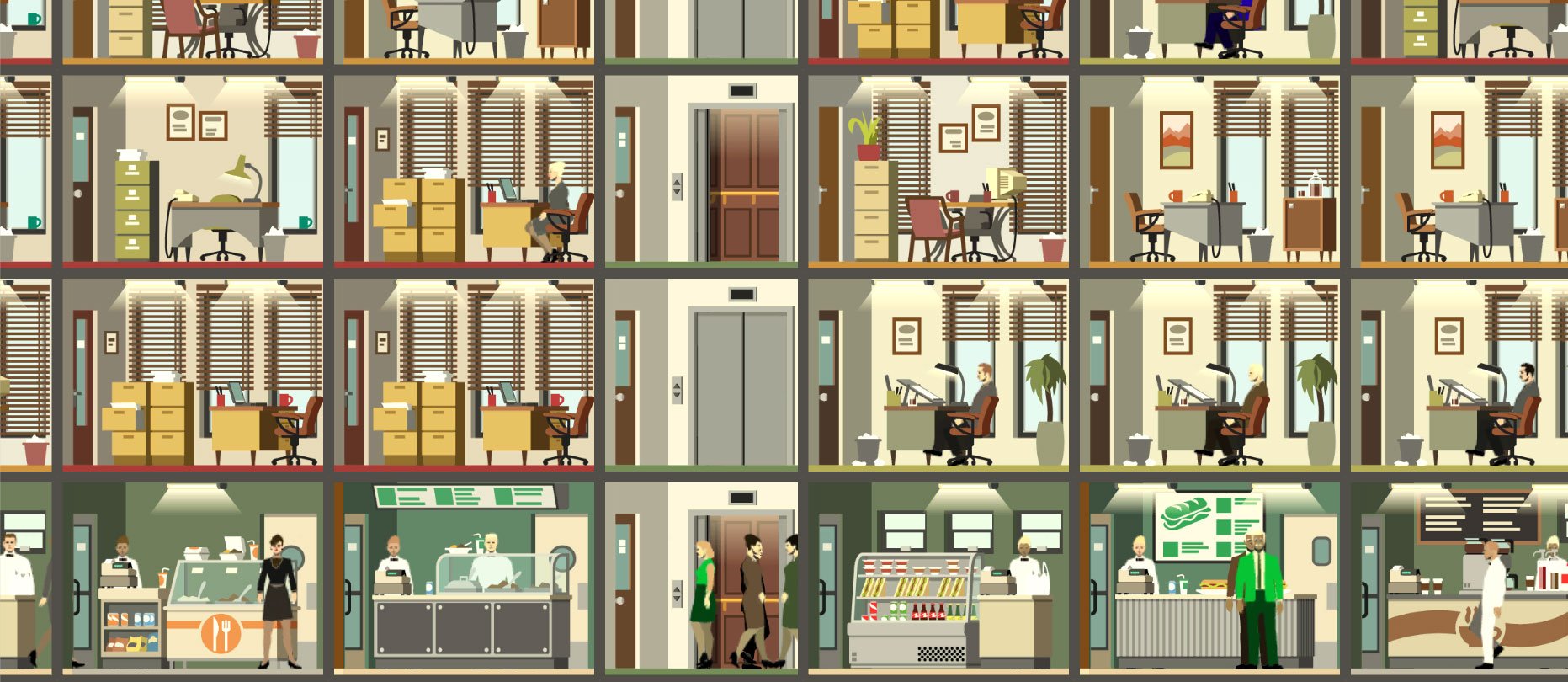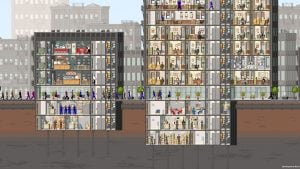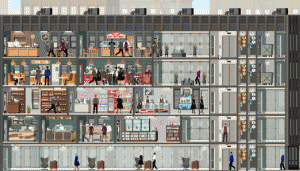Features
A Chat with SomaSim About ‘Project Highrise’

I got the chance to ask a few questions of Matt Viglione of SomaSim about his and Rob Zubek’s upcoming simulation strategy game Project Highrise, and he was kind enough to answer them. We’re really excited to follow the evolution of the studio and its new project, so expect to see more coverage in the near future.
MJR: For the uninitiated, give us a really quick rundown on just what Project Highrise is and what they can expect from the game.
MV: In a nutshell, Project Highrise is a skyscraper construction and management simulation game. You’re the architect, general contractor, and building manager of a highrise tower. You end up being in charge of a complex urban ecosystem that needs your guidance to grow and prosper.
How did SomaSim get its start, and can you give us a little bit of background information on the two of you?
Well, first of all, you’ve got to know that we’re simulation and strategy game addicts. That predates SomaSim by a very long time. I got hooked on Caesar II, SimCity, and (of course) SimTower when the genre was still young. I eventually became a graphic designer and I think I enjoyed that work so much because it’s very much like laying out a city in a sim game. I spent 15 years or so doing that work to finance my simulation game habit. Now I’m lucky enough to fund it by designing simulation games.
On the other hand, Rob [Zubek, the co-founder of SomaSim] has been programming for many years, including games development, and is also a huge sim fan. We had always talked about making our own sim games, and the recent growth of distribution platforms like Steam made it possible for us to actually take a stab at making and selling games as a tiny team.
Honestly, Project Highrise was the game that we wanted to make right out of the gate, but we quickly realized that it was too big to be a first game—mostly because we knew it would take at least two years to achieve it and we could only afford about half that. So while we were driving through California’s Gold Country to see some friends, we were inspired to make 1849 and that became the studio’s first game.
There seems to be a lot of complexity in Project Highrise, making it more of a spiritual successor to SimTower or Yoot Tower rather than, say, Tiny Tower. Just how complex a simulation are you aiming to build?
Our goalposts for complexity are games like Cities: Skylines or Prison Architect, so more modern takes on the simulation genre. And these are the kinds of games we enjoy playing, too.
In that kind of a simulation, there are a lot of different, independent systems that come into play and interlock, like gears in a watch. So the player has to take the time to figure out how each piece affects the others, to learn out how the entire clockwork functions and become really good at it. At the same time, these elements only get introduced over time, so you have the time to learn how to harness the basic systems before the more complex ones start kicking in. So yeah, we’re definitely not making a casual game. 🙂
In pre-release information you guys have given out, there’s been discussion of players being able to take their towers in different directions, such as providing rooms for tourists, a home for corporate infrastructure, or condos to people who want to live the high life. Are these discrete paths, or will players have the freedom to follow any mix of design planning that seems interesting to them?
Yes, we’re trying to support both! The game supports the mixing of different tenants together, although it’s not always going to be the best or smartest thing to do. For instance, in sandbox mode, players can build anything that they like in any combination – but they’ll soon learn that, for example, trying to keep luxury apartments happy when they’re next door to a loud and busy tech startup will be a pretty tall order. So they will have to figure out combinations that work best for them, based on what kind of a building they want to have.
Then on the other hand, there will also be campaign scenarios, and some of them may have very specific restrictions: for example, you may have a scenario where you’re renovating an old office building, and so you’ll be prevented by zoning limits from having any residential apartments. Then you’ll have to figure out how to make that work best within the constraints you have.
Screenshots of the game have shown both small-scale buildings and impressively huge creations. One of your most recent blog posts shows more than 80 rooms (at a rough estimate). Just how big will Project Highrise allow players to go in terms of floor limits and numbers of rooms?
Our goal was always to allow players to build very tall towers with a large number of tenants. We’ve done quite a bit of technical work to make sure that the game can support as many as 1,000 characters onscreen at the same time. On the design side, prestigious towers that attract corporate HQs and penthouse views more or less necessitate a large tower. In sandbox mode, players will be pretty free to build as tall and as large as they desire.
And sure enough, our beta testers have really enjoyed building some monster skyscrapers. Just the other day we got one save game that’s pushing 70 stories and has a few hundred business tenants. Just to compare, the real-world Willis Tower in Chicago, until recently the tallest building in the United States, tops out at 108 stories.
We know that there will be limits placed upon aspiring builders by the city, but will players be able to circumvent those limitations, or will they be hard limits in individual scenarios?
A bit of both. In scenarios, there will be some hard limits that players can’t get around. But we tried to keep those to things that make sense in the fiction of a skyscraper at the heart of an urban core. For example, in one scenario, you’ve got a very narrow lot so you’re limited in the width of tower that you can build. But that just means that you have to go tall right away. In another scenario, we start the player on a lot that sits on top of subway tracks, so the player can only build a few floors underground, thus suddenly managing and optimizing underground infrastructure becomes a more urgent priority.
In scenarios and in sandbox play, players will start with some height and area limitations. But they can get around those to a degree by lobbying city hall for exemptions. In our research, we found out that developers get exemptions like this for doing things like building public space or participating in civic initiatives, so we wanted to include that aspect in the game as well.
Will city-mandated limitations be randomized upon starting a new game, or does Project Highrise place more emphasis on the preset scenarios?
It depends on the game mode. In sandbox, players will choose a preset lot and some basic zoning – so for example, they might choose a narrow lot that allows for a tall tower. Or they might opt for a wide lot that doesn’t allow for a very tall tower. The limits in sandbox play will be pretty loose. In scenarios, players are going to run into much firmer limits. Some sim game players really like to follow campaigns and play scenarios, while some enjoy the open play of sandbox a lot more. We wanted to fully support both styles.
What sort of win conditions will there be for your average game? Are there goals like building to a certain size, or making a certain amount of money, or does the game take a more open-ended approach like the original SimTower?
Here too we’re trying to support both! In campaign mode, each scenario has specific victory conditions, with three goal posts with increasing difficulty for the player to achieve in order to complete the scenario. On the other hand, play in sandbox mode will be entirely open-ended.
However, players will have a series of optional contracts from the city in both modes that can guide them if they want. They’ll provide a cash boost if they’re taken on and completed, but they’re by no means mandatory.
We’ve mentioned SimTower numerous times already, so can you explain for fans of those games exactly what Project Highrise plans to do differently (or what new features you’re adding to that classic formula)?
While that game was definitely hugely inspirational, Project Highrise is by no means a remake. Sim games as a genre have come a long way since then. Let me give you a couple of examples of how the inspiration from SimTower translated into Highrise.
First, we have the same sort of broad categories—offices, apartments, restaurants, stores. But where SimTower has one type of office, we’ve got about two dozen. Each has its own requirements, needs and desires. Accountants look for different things in an office tower than doctors. The same variety and diversity is true for apartments, stores and restaurants.
Also, SimTower was very much about the building, with a lot of emphasis on floor construction and elevator management, but it didn’t really focus too much on the economics of real estate. Our goal is to have much more of an economic game—how do you keep your tenants happy, and your building profitable, when everybody has different ideas of what they need, and they’re difficult to keep happy together? In Highrise, as your building grows and becomes larger, players will see different challenges emerge, and it’s more of an ecosystem where changes can have both intended and unintended consequences.
Awesome. The game does seem to have a surprisingly large number of systems all working together at once. How have you gone about trying to ease players into learning it all while still maintaining the strategic complexity?
By slowly unlocking new systems as players progress through building their tower. The game has several implicit and explicit progression systems. We took a bit of inspiration from 4x games like Civilization. Players start out small with either bare ground or a very small building and then expand from there. As they gain size, population, and prestige, that makes new features and systems available.
Additionally, some of the game systems don’t “wake up” until later in the game, because they’re second-order effects that stem from the player interacting with more basic systems. For example, grime and disrepair don’t happen until later in the game, because they’re caused by foot traffic, which initially won’t be intense enough to cause any significant wear and tear—but later on as the building gets large, it becomes a real concern.
What have been some of your most difficult or infuriating challenges as you’ve been developing the game?
On the design side, with all of the interlocking systems, it’s a constant challenge to balance and tune the game. Changing one value, like the cost of electricity, can have knock-on effects that are hard if not impossible to envision. So I’ve got a couple dozen spreadsheets each with multiple sheets and some ridiculous formulas with dependencies that I would be hard-pressed to explain. Those help figure out some numbers, but just because you’ve got some numbers that look balanced or seem to make sense in a spreadsheet, the spreadsheet is not the game. And spreadsheets are not fun. So tuning basically goes like this: change some numbers in a sheet. Apply them to the game. Play for a couple hours. Sometimes you discover that your change has indeed improved the game. Sometimes you discover that what you assumed would be fun is just awful.
That kind of balance fascinates me. I love complex systems, but also don’t have the disposition to wade through them on quite that level. So on the other side of the coin, is there anything that’s been incredibly gratifying as you’ve continued development, or anything that went better than you expected?
Definitely the art production. We wanted to have a lot of visual diversity in the game, for penthouse apartments to have a visual quality that is markedly higher than a small studio apartment. We wanted a late game tower to have a visual quality and appeal that was satisfying to the player, that they would take pride in having built. Early on we came up with a system of making everything modular—from walls and windows down to pen holders and pieces of fruit—that provides a great visual vocabulary with which we can express a great variety of units, from cheap to expensive, from basic to meticulously decorated.
>We also were very happy with the feel of hustle and bustle of our simulated people. It’s surprisingly rewarding to watch people come in in the morning, go get a cup of coffee, go work at their desks, then the crowds gathering around food court restaurants at lunch time, or the rush to elevators as the workday draws to a close. And then the night time shift, doing repairs and janitorial work while the building is empty. It really makes the building feel like it’s being lived in.
Can’t wait to see that in action, as that’s some of what I love most about this kind of sim.
So while your first game, 1849, seems to have some similarities to Project Highrise, it also seems to have a wide array of differences. Were there any lessons you learned from 1849 that are helping you make Highrise a better game?
We flipped about our design method for Highrise. In 1849 we focused on scenarios and campaigns first and sandbox only once we were happy with those. That made sense for it as it was all about progressing through the Gold Rush in succession since its very first design doc. I think the sandbox in 1849 suffered from that. It ended up not being as compelling as it could have been. For Highrise, our goal was really to have both be great, so we started by working on the open play sandbox first. Only once we felt that the sandbox mode was where we were getting happy with it did we move on to working on the scenarios. I think the game is a lot better because of that.
So here’s the last thing we really need to know: how soon can players expect to get their hands on Project Highrise?
We’re targeting late summer of 2016!
For more on Project Highrise and SomaSim games, check out their website and devlog, and keep your eyes on GoombaStomp.com for more future coverage!

-

 Features3 weeks ago
Features3 weeks agoDon’t Watch These 5 Fantasy Anime… Unless You Want to Be Obsessed
-

 Culture3 weeks ago
Culture3 weeks agoMultiplayer Online Gaming Communities Connect Players Across International Borders
-

 Features3 weeks ago
Features3 weeks ago“Even if it’s used a little, it’s fine”: Demon Slayer Star Shrugs Off AI Threat
-

 Features1 week ago
Features1 week agoBest Cross-Platform Games for PC, PS5, Xbox, and Switch
-

 Game Reviews3 weeks ago
Game Reviews3 weeks agoHow Overcooked! 2 Made Ruining Friendships Fun
-

 Guides4 weeks ago
Guides4 weeks agoMaking Gold in WoW: Smart, Steady, and Enjoyable
-

 Game Reviews3 weeks ago
Game Reviews3 weeks agoHow Persona 5 Royal Critiques the Cult of Success
-

 Features2 weeks ago
Features2 weeks ago8 Video Games That Gradually Get Harder
-

 Features1 week ago
Features1 week agoThe End Is Near! Demon Slayer’s Final Arc Trailer Hints at a Battle of Legends
-

 Features2 weeks ago
Features2 weeks agoDon’t Miss This: Tokyo Revengers’ ‘Three Titans’ Arc Is What Fans Have Waited For!
-

 Guides2 weeks ago
Guides2 weeks agoHow to buy games on Steam without a credit card
-

 Game Reviews1 week ago
Game Reviews1 week agoFinal Fantasy VII Rebirth Review: A Worthy Successor?























